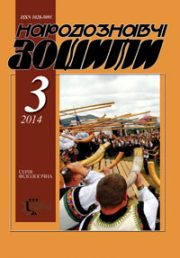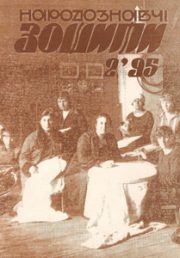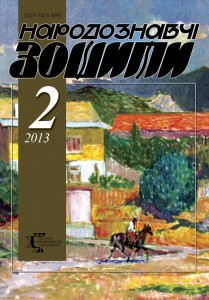2013 year, issue 2
The article deals with studies in Ukrainians’ traditional dwelled and household complexes of constructions by active members of Lviv Shevchenko Scientific Society through the late XIX and early XXI cc. Under analysis have been put general results of research by authoritative experts in national construction, as Volodymyr Shukhevych, Mykhailo Zubrytskyi, Ivan Franko, Volodymyr Sichynskyi, Raimund Friedrich Kaindl, Roman Radovych, Roman Siletskyi, Arkhyp Danyluk and other scholars.
Keywords: ethnology, people’s construction, late XIX and early of XXI cc., Lviv Shevchenko Scientific Society.
Keywords: ethnology, people’s construction, late XIX and early of XXI cc., Lviv Shevchenko Scientific Society.
In the article have been considered several folklore customs and beliefs connected with church Easter service. Some magical properties of sanctified products as well as practices of their ritual use have been characterized. Especial attention has also been paid to a set of different techniques for recognition of witch in church; these still are marked by original local features.
Keywords: Easter, Volhynia, custom, belief, prohibition, sanctification, protectiveness, witch.
Keywords: Easter, Volhynia, custom, belief, prohibition, sanctification, protectiveness, witch.
In the article has been considered one of most important problems connected with heating systems of Polissian dwellings, viz. to methods of smoke extraction. The author’s attention, particularly, has been concentrated on dynamism in liquidation of smoked heating and time of penetration of semi-smoked and “clean” ones in Polissians rural dwellings. In the study have been defined certain peculiarities of smoke-extracting equipment, their constructions, areals, diachronicity etc.
Keywords: Polissia, dwelling, stove, smoke tube, flue, smoked heating, semi-smoked heating, «clean» heating.
Keywords: Polissia, dwelling, stove, smoke tube, flue, smoked heating, semi-smoked heating, «clean» heating.
In the article has been considered deportation of Ukrainian population from Poland to Ukrainian SSR, in particular to eastern regions of the country. The study has brought some data on changes in planes of settling the deportees at the very beginning of the process. Main points of concentration and the number of families re-settled to the east of Soviet Ukraine in the second half of 1940s have been marked.
Keywords: population, deportation, Poland, Ukrainian SSR, settlement, Transcurzonia
Keywords: population, deportation, Poland, Ukrainian SSR, settlement, Transcurzonia
Taras Yaroslav. On stone walls and gates of moldavian country seats. P. 238-246
In proposed article have been considered some architectural constructive schemes of gates for Moldavian country seats and their compositional lay; light has been thrown upon the origin of singular styling in decorative processing of gate stones in connection with décor of galleries of homes. Attention has been paid to architectural motifs in the headings of pillars. Materials of study have been accompanied with large amount of illustrations.
Keywords: wall, gate, stone, gallery, Moldavia, décor, motif, pillar
Keywords: wall, gate, stone, gallery, Moldavia, décor, motif, pillar
In the article for the first time have been considered some problems of history and peculiarities in carved iconographic finishing of Our Lord’s Ascension and Transfiguration Churches. Visitatios of 1760 had described women’s monastery complex north-westward from Rohatyn and enumerated convent property. Survived in the village of Nadrichne (previously known as Dryszczów ) convent church of Our Lord’s Transfiguration with iconostasis and altar table has been the main object of research. Analysis of art-stylistic features in the décor of survived monuments has made possible quite audacious proposals as for their origins.
Keywords: Convent of Basilian Sisterhood, iconography, stylistics, iconostasis, Rohatyn region.
Keywords: Convent of Basilian Sisterhood, iconography, stylistics, iconostasis, Rohatyn region.
Boiko Ihor. On formation of ethnical ecology and its perspectives in ukrainian science. P. 256-265
In the course of analytic research-works as for development of ecological knowledge and formation of ethnical ecology as a separate science a point has been stated that ethnical ecology and adjacent fields belonged to most developed and popular disciplines in scientific world; the development of Ukrainian science on a human in the nature had progressed in the world scientific circles and had afterwards been expelled out of those by the Soviet totalitarian machine; in the Soviet Union had been made quite considerable scientific achievements used abroad; contemporary Russian as well as Czech, Slovak and Polish scholars and educationists have actively moved their discoveries into the world circulation and pay especial attention to ethnical ecology and structural anthropology; these circumstances have made more evident the need of analogical integrative processes in Ukrainian studies.
Keywords: ethnical ecology, cultural ecology, structural anthropology, ethnical ecosystem, cultural core.
Keywords: ethnical ecology, cultural ecology, structural anthropology, ethnical ecosystem, cultural core.
Collection of the late XIX and early XXI cc. clay sculptures kept at the Opishne National Museum-Reserve of Ukrainian pottery is reviewed in the article. In the course of research-work present exhibits have been analyzed and divided into several groups according to their forms and functional destination, acoustic characteristics as well as periods of production, centres of craft, means and time of acquisition by museum repositories.
Keywords: collection, clay toys, «svystunets», «coin», sculpture of small forms, National Museum-Reserve of Ukrainian Pottery in Opishne.
Keywords: collection, clay toys, «svystunets», «coin», sculpture of small forms, National Museum-Reserve of Ukrainian Pottery in Opishne.
Pakholok Inna. On ethnographic specificity of trinity plants. P. 272-278
In the article have been systemized and analyzed Ukrainians’ traditional beliefs, warnings and prohibitions tied with the choice of certain plants for decorating of dwellings and homestead construction on the eve of the Trinity Festival. On the basis of her own ethnographic field studies as well as published sources and data of scientific literature the author has thrown light upon regional traditions of klechannya (may) customs, found their main criteria of choice and ethnographic specificity.
Keywords: ethnology, Ukraine, historical and ethnographic regions, climatic conditions, national ideas, trinity plants, custom.
Keywords: ethnology, Ukraine, historical and ethnographic regions, climatic conditions, national ideas, trinity plants, custom.
The article has brought an outlook of life and scientific activities by Polish ethnologist and linguist Stanisław Ciszewski against the background of developmental processes in Lviv University as a leading university of Galicia during the early XX c. The author has described Stanisław Ciszewski’s biography with especial attention to formation of his scientific Weltanschauung and tuition at the Chair of Ethnology, Lviv University.
Keywords: Stanisław Ciszewski, Chair of Ethnology, Lviv University, lecture, ethnology, ethnography.
Keywords: Stanisław Ciszewski, Chair of Ethnology, Lviv University, lecture, ethnology, ethnography.
In the article have been considered some peculiarities in the development of Galician professional hosiery at the late XIX and the first third part XX cc. General tendencies have been defined with characteristics of productive centres and analysis of hosiery assortment and its art-stylistic features. The evolvement of hosiery industry along the Western Ukrainian territories has been marked in the contents of European impacts and interrelations with regional trraditions. Quality of production, typological structure and aesthetical finishing in décor of artifacts has proven quite high level of professional hosiery in Galicia at the late XIX and the first third part XX cc.
Keywords: hosiery, professional, artistic, education, workshops, assortment, exhibitions, ornament, décor.
Keywords: hosiery, professional, artistic, education, workshops, assortment, exhibitions, ornament, décor.
Dyadyukh-Bohatko Natalia. On typology of weapon in Hutsul land (artistic peculiarities). P. 306-312
Keeping in mind the range of functional groups as Hutsul kris gunsas well as pistols, knives, bartka hatchets etc. the author has proven their artistic value in chronologic and regional aspects. Definitions have been elaborated as for peculiarities in classification and typology of decorated Hutsul fire-arms.
Keywords: weapon, art, weaponry, typology, function, form.
Keywords: weapon, art, weaponry, typology, function, form.
In the article some light has been thrown upon less-known pages of Mykola Fediuk’s and Mykhaylo Osinchuk’s collaboration with Lviv National museum. During long time these painters’ creations had been associated with Greek-Catholic tradition of religious artistry; M.Fediuk and M.Osinchuk had taken active part in the development of Ukrainian art (sacred one, in particular) through the first half of XX c., the time widely known as Ukrainian Renaissance. The study has at large been based on archival data.
Keywords: Mykola Fediuk, Mykhaylo Osinchuk, Ukrainian art, Greek-Catholic tradition.
Keywords: Mykola Fediuk, Mykhaylo Osinchuk, Ukrainian art, Greek-Catholic tradition.
Skrynnyk-Myska Daryna. Roman Yatsiv and a revival of lost sences. P. 322-326
In the article has been considered a research field by Lviv art scholar Roman Yatsiv who during recent years enriched the Ukrainian science with a number of new editions on the native Fine Arts as well as their history and development in XX c. Especial attention has been paid to the meaning of those publications that substantially widened a source basis of studies and deepened comprehension of aesthetical communication in contemporary and postmodern period. In analysis of some R. Yatsiv’s theoretic and methodological fixations an attempt has been made to connect those with his creative aspiratios of artist.
Keywords: Roman Yatsiv, art of XX c., modernism, sence of art, art criticism, theory of art.
Keywords: Roman Yatsiv, art of XX c., modernism, sence of art, art criticism, theory of art.
In the article have been presented some functional, stylistic and technical features of Ukrainian paper-cuts produced by professional craftsmen. Analytic studies in plastical transformations of paper-cut works has pointed diplomaed artists concerned with this kind of creative activities. Signs of «professional paper-cut» have been determined.
Keywords: paper-cut, artistic features, function, stilistika, technique, professional artists.
Keywords: paper-cut, artistic features, function, stilistika, technique, professional artists.
Molyn Valentyna. On ukrainian department of Galicia at Odessa exhibition. P. 333-335
In the article some light has been thrown upon an event that took place at Odessa in 1911, viz. organization of industrial and agricultural exhibition, attended by Ukrainian Galician societies and private persons as well as folk artists from Hutsul region, e.g. woodcarvers V.Shkriblak and M. Mehedyniuk, weaver D.Prukhnitsky of Kosiv and other craftsmen.
Keywords: Ukrainian economical and educative societies, Levynsky, Prukhnitsky, Shkriblak, Mehedyniuk.
Keywords: Ukrainian economical and educative societies, Levynsky, Prukhnitsky, Shkriblak, Mehedyniuk.
In the article have been considered some means for arrangement of urban residences in the Ukrainian national traditional style through 1920s and 1930s. Author has traced the influence of printed publications, especially the impact of styling by «Nova Khata» [New Home] magazine upon shaping of Galician residents’ tastes as for home décor and furnishings.
Keywords: «Ukrainian style», residence, home décor and furnishings, interior, «New Home».
Keywords: «Ukrainian style», residence, home décor and furnishings, interior, «New Home».
In the article have been presented some results got during an attempt of systematization and scientific interpretation of painted creations by Svyatoslav Hordynsky (1906—1993), eminent artist, poet, translator, organizer of artistic life in Lviv as well as in diaspora. To general considered specimens belong paintings created in the course of most intensive search for new formal artistic qualities in 1920s and 1930s and obliquely — works of WWII period and artist’s first emigrational years in Germany and USA
Keywords: Svyatoslav Hordynsky, painting, modernism, vanguard, expression, Art Deco, landscape, stylization, aut5hor’s creative method
Keywords: Svyatoslav Hordynsky, painting, modernism, vanguard, expression, Art Deco, landscape, stylization, aut5hor’s creative method
Shepet Tetyana. On poster art in creative work by Eugeniusz Get Stankiewicz. P. 350-355
The article has brought an analytic study in creativeness by Get Stankiewicz, eminent Polish graphic artist and sculptor, whose work was and still is exemplary and inviting further investigations as for its artistry as well as in its social comprehension. Graphic works being reflections on cultural events and artistic expressiveness have been considered in the course of research. Review of some stylistic and compositional features in self-portraits has been performed. In self-portraiture have been traced transitions from the easel graphical techniques to poligraphic printing. Polish creators’ milieu and directions in processes of artistic development have particularly belonged to the subjects of the survey.
Keywords: easel graphic technique, poster, copperplate etching, self-portrait, Polish school of graphic art.
Keywords: easel graphic technique, poster, copperplate etching, self-portrait, Polish school of graphic art.
The article has been devoted to analysis of some fundamental historiographical problems in cognition of Ukrainian art of Princes’ epoch. The influence of Alypius’ school of painting upon artistic processes of Eastern and Western Europe has been noted.
Keywords: Alypius of the Caves, Kyivan antique painting school, D. Alighieri, Picasso, A. Petrytsky, О. Bohomazov, Z. Lerman, H. Havrylenko and his school, V. Favorsky and his school.
Keywords: Alypius of the Caves, Kyivan antique painting school, D. Alighieri, Picasso, A. Petrytsky, О. Bohomazov, Z. Lerman, H. Havrylenko and his school, V. Favorsky and his school.
In the article some light has been thrown upon exhibitive activities by the staff of the Museum of ethnography and artistic crafts, a department of the Ethnology Institute of NASU (2012). During this year there took place quite a number of exhibitions completed out of fund stores with re-organizing of permanent exposition. A series of international projects has been realized as well as presentation of native and alien traditional folk and professional decorative applied art. Numerous creations of painting, sculpture, graphical art and artistic photography have been presented to the audience.
Keywords: The Ethnology Institute of NASU, Museum of ethnography and artistic crafts, exhibitive activities, 2012.
Keywords: The Ethnology Institute of NASU, Museum of ethnography and artistic crafts, exhibitive activities, 2012.
Kharchyshyn Olha. New folkloristic work on Lemkos and Lemko land. P. 378-381
read »








